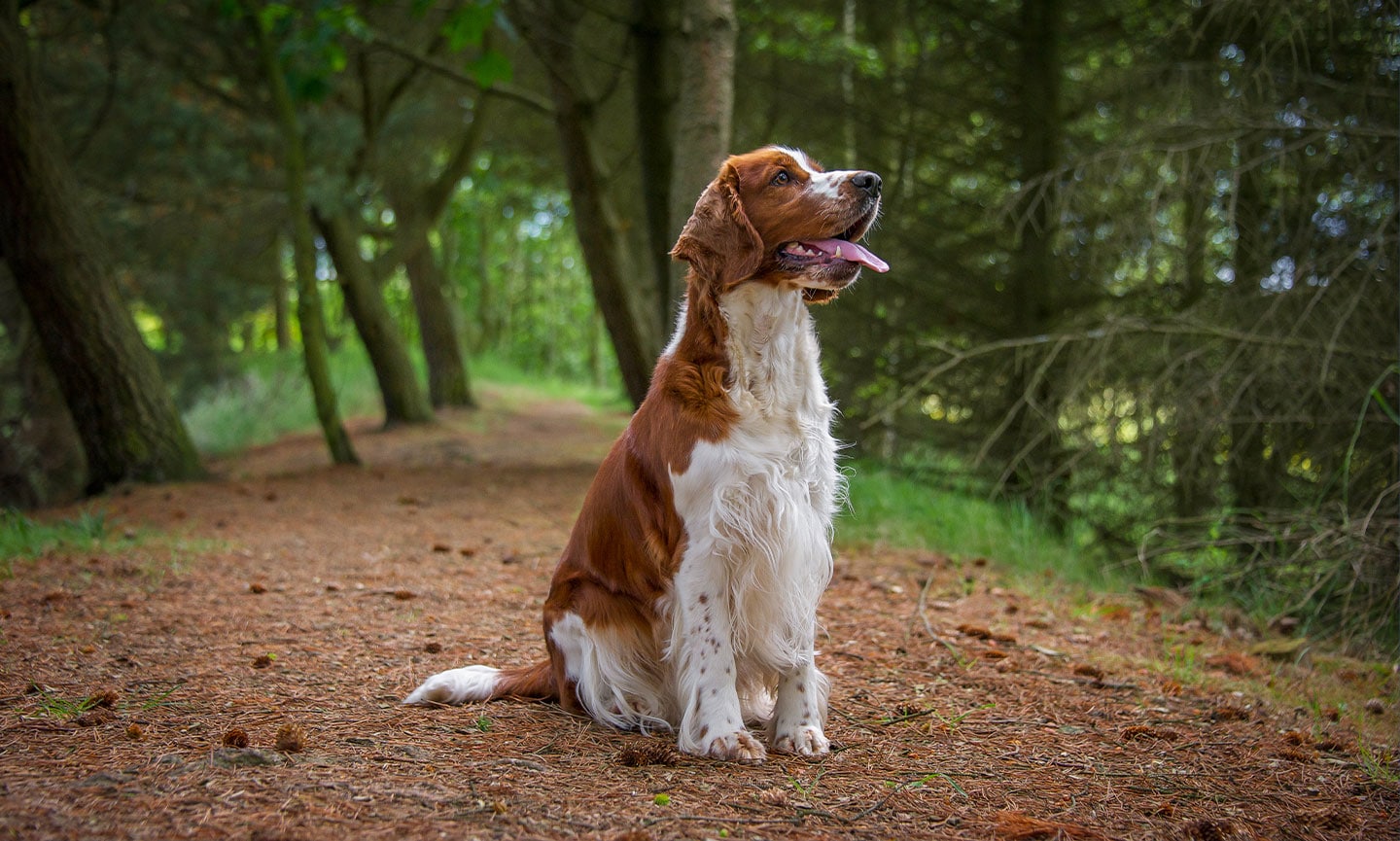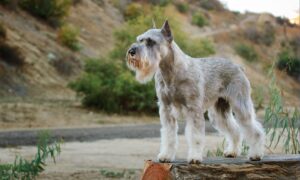Welsh Springer Spaniel
Updated December 15, 2025
Welsh Springer Spaniel
Updated December 15, 2025
Welsh Springer Spaniels are loyal and energetic dogs who need regular grooming and plenty of adventure. They thrive in active homes with pet parents who enjoy outdoor activities and can provide consistent training.
Intelligent, Athletic, Graceful
Male: 40-55 pounds
Female: 35-50 pounds
Male: 18-19 inches
Female: 17-18 inches
12 to 15 years
Red and White
Even if your own “hunting” activity is limited to finding the best bench at the park or buried treasure at the flea market, Welsh Springer Spaniels, born to run and famous for their prowess at flushing out game for which they were once bred, are all about riding shotgun on your adventures. Smart, agile, loyal, loving and totally gorgeous in that sporty countryside sort of way, Welshies, as they are known, will be your go everywhere, do anything furry pal. If you are looking for a medium-sized, sweet-tempered dog with exceptional athletic ability who really just wants you more than anything, and you can provide the kind of active lifestyle that their high-energy demands (they’re called “Springer” for a reason), they’re the total package.
Welsh Springer Spaniel Characteristics
Welsh Springer Spaniel Appearance
Gorgeous and graceful, the Welsh Springer Spaniel will catch your eye before capturing your heart. Their soft red and white coat covers a compact, agile body, and their ears are delightfully floppy and lightly feathered. They often have flecks on their muzzles, which look a lot like freckles.

- Ears
Welsh Springer Spaniel ears are floppy, medium-sized and lightly feathered.
- Eyes
Welsh Springer Spaniel eyes are medium to dark brown and oval in shape with a soft expression.
- Nose
Welsh Springer noses are typically black or brown.
- Coat Length
Their coat is soft and straight and medium length with moderate feathering on the hind legs, chest and underside.
- Coat Color
Welsh Springer Spaniels have a red and white coat. Some of the white areas may be flecked with red ticking.
- Tail
The AKC breed standard allows for the tail to be docked or undocked. Docking involves cutting a portion of the dog’s tail off when they are puppies. Veterinary groups along with many U.S. states and countries have banned this procedure due to medical and behavioral reasons. If you are interested in this procedure, schedule a consultation with your veterinarian.
Welsh Springer Spaniel Temperament
The Welsh Springer Spaniel is a beautiful, athletic dog who’s easy to train and even easier to love. They’re the perfect blend of grit and grace, and like the girl who runs a mile without breaking a sweat, Welsh Springers will tear around the park and look gorgeous while doing it.
They’ve got an irresistibly sweet temperament and a sharp mind, too. They’d make a wonderful addition to any family and will love your kids almost as much as you do. But don’t expect them to lavish kisses all over your visiting friends and relatives—Welsh Springer Spaniels tend to be reserved when meeting strangers, and it may take a little time for them to warm up to new people.
Thankfully, that reserved nature doesn’t translate into unwanted behavior; though they may be a bit aloof around newcomers, they’re rarely aggressive and not prone to biting. They can even live happily with cats and other dogs in the household, if given the proper training and socialization.
Welsh Springers have a pretty high energy level and need daily exercise to burn off the wiggles. But rest assured, a well-exercised Welsh Springer is a happy Welsh Springer, and at the end of the day, they’ll be happy to curl up and cuddle with you.
How to Care for a Welsh Springer Spaniel
Welsh Springer Spaniels are your typical sporting dog: smart, lively and athletic. They need mental and physical stimulation through daily exercise and training. But the slightly higher level of energy you put into training is balanced out by their moderate grooming needs—thanks to their weatherproof coat, grooming is a breeze, and a weekly brushing and nail trim plus a bath whenever they get dirty is all that’s necessary.
Grooming
Training
Diet
Exercise
Environment
Welsh Springer Spaniel Health
The Welsh Springer Spaniel has a life expectancy of 12 to 15 years, but they are susceptible to a few serious health problems. Thanks to the efforts of responsible breeders, these conditions are becoming less common. Hopefully you won’t experience any of these health issues with your own Welsh Springer, but it’s best to learn about them so you know what to look for and to keep your dog happy and healthy throughout their life.
- Hip Dysplasia: Hip dysplasia is a hereditary condition that occurs when the ball and socket in the hip joint doesn’t fit together properly. In Welsh Springer Spaniels, the likelihood of this occurring can increase when dogs are spayed and neutered before their second birthday. Treatment options can include medication, physical therapy or surgery, depending on the severity of the case.
- Elbow Dysplasia: Like hip dysplasia, elbow dysplasia is another hereditary disorder of the joint that can be treated through surgical and non-surgical methods. Symptoms include swollen joints or difficulty getting up. Surgery is recommended in most cases. Because it’s genetic, reputable breeders test their stock to make sure they don’t pass the condition on to their puppies.
- Glaucoma: Glaucoma is caused by fluid buildup in the eye. The pressure created by this buildup can eventually cause blindness if left untreated. Treatment may include eye drops, medication or surgery. Another hereditary condition, breeders are taking measures to reduce its occurrence.
- Autoimmune Thyroiditis: The Welsh Springer Spaniel is genetically predisposed to autoimmune thyroiditis. This condition causes the immune system to attack the thyroid gland, diminishing its effectiveness. Though it can be treated through daily medication and routine blood work, it’s best to purchase your pet from a responsible breeder who screens their stock for this condition.
- Ear Infections: With their adorably floppy ears and fondness for the outdoors, Welsh Springers have a tendency to develop ear infections. Pups who spend a lot of time outdoors tend to get more debris or water in their ears, which can lead to infections. Symptoms may include head shaking, redness of the ear canal, scratching, brown or yellow buildup and a yeasty odor. Topical ear drops and antibiotics are common treatments for this condition. Weekly ear cleanings can help keep the infection from returning.
Welsh Springer Spaniel History
The Welsh Springer Spaniel can trace their origin back to Wales—no surprise there! But what you may not know is that they’ve been around for hundreds of years. Originally developed to flush out game in the days before guns, this astute hunting dog would spring from their hiding place and drive game straight into the hunter’s net. This spring-like action is how the breed earned their name.
Even after the advent of guns, Welsh Springers proved to be useful in the field; after flushing out prey, they would retrieve it and bring it to their masters. Hunters prized the Welsh Springer Spaniel dog for being the perfect blend of helper and companion. With their temperate, affectionate demeanor, they made excellent additions to the family.
Many people assume that Welsh Springer Spaniels and English Springer Spaniels are closely related. After all, they do look alike, act alike and come from the same island. But despite their similarities in looks and abilities, these two breeds developed separately. And there are some slight differences between them: Welsh Springer Spaniels are a bit more reserved than English Springers, and they only come in one glorious color combination—red and white.
Welsh Springers also never enjoyed the same wide-spread popularity as English Springers. Though they were officially recognized by the American Kennel Club in 1914, their numbers dropped off so drastically after World War II, that few, if any, remained in the United States.
Thanks to Welsh Springer Spaniel enthusiasts, the breed was reintroduced and revived in the US. Current breeders—who are also devoted fans of the breed—do all they can to keep their lineage going. If you’re thinking of adding a Welsh Springer Spaniel puppy to your family, be prepared to pay around $1,800 to $2,000. But for that price, you’re likely getting a pup who’s been screened for health and temperament issues and may come with pedigree papers. The best way to find a reputable breeder is through the American Kennel Club website. You can also check with Welsh Springer Spaniel rescues, keep an eye out for the breed at your local shelter, or search Chewy’s database of adoptable dogs in your area.
FAQs
Do Welsh Springer Spaniels shed?
Are Welsh Springer Spaniels good family dogs?
How long do Welsh Springer Spaniels live?
Are Welsh Springer Spaniels good with cats?
Expert input provided by: Dr. Anthony Hall, Veterinary Consultant at Airvet; Matt Schimsky, CPDT-KA, Owner of Tuff Pup Traning, LLC in Philadelphia, Pa.; Allison Lamminen, CTC, CSAT, Owner of Delighted Dogs; Beth Mullen, CBCC, KPA-CTP, Owner/Founder of Dog Latin Dog Training & Behavior Consulting; and Susan Riese of Statesman Welsh Springer Spaniels in Covington, Ga.
Breed characteristic ratings provided by veterinarian Dr. Sarah J. Wooten, DVM, CVJ, a veterinarian at Sheep Draw Veterinary Hospital in Greeley, Colorado; dog trainer and behavior consultant Irith Bloom, CPDT-KSA, CBCC-KA, CDBC, owner of The Sophisticated Dog, LLC, in Los Angeles; and certified animal behavior consultant Amy Shojai, CABC, in Sherman, Texas.
The health content was medically reviewed by Chewy vets.








